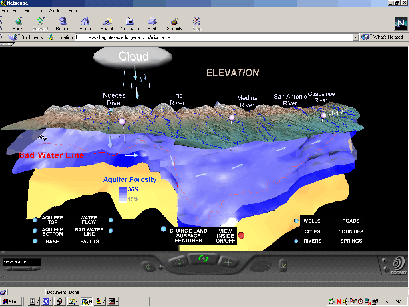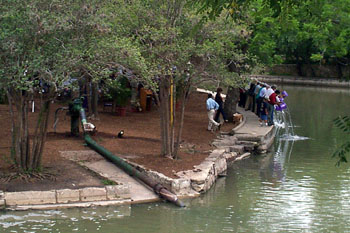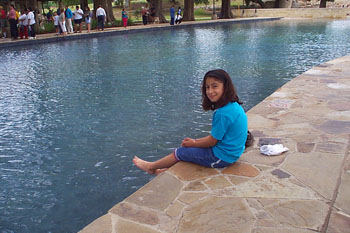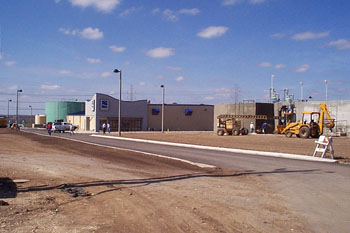
|
|
|
|
Comal county approves Aquifer protection rules On December 21, 2000 the Comal County Commissioners Court adopted new rules proposed by the County's Water Wise Committee requiring developers to prove they can provide water to new homes. Builders must drill test wells and monitoring wells, and hire hydrologists to certify the Aquifer will be sufficient for homes planned for the next 30 years. County Judge David Scheel said "Now the committee will have to take on impervious cover rules," which would limit parking areas and other ground covers that could affect Aquifer recharge. Nine new endangered species listed In December 2000 the US Fish & Wildlife Service listed as endangered nine cave-dwelling invertebrates that live predominately in northern Bexar county. Environmentalists hoped the move would limit explosive growth that had been occurring over the recharge zone, and developers feared the same effect. The listings included three species of beetles, five spiders, and one harvestman, which is similar to the common household daddy-longlegs. Nancy Kaufman, regional director of the Service's Southwest Region, said. "Though not as majestic as the bald eagle or as appealing as the black-footed ferret, these species are unique and fascinating creatures that also serve as good indicators of the overall health of the ecological systems on which humans ultimately depend. When species like these nine invertebrates begin to disappear from the planet, it is a sign that the natural world around us is under a great deal of stress." For more on the newly listed species see the page on Endangered Species. First land purchases made using Aquifer protection tax In December 2000 the first purchase of sensitive land was made using funds generated by Proposition 3, a 1/8 cent sales tax that took effect in October 2000. The San Antonio City Council voted to spend almost $6.8 million to acquire 1,033 acres of pristine land adjacent to Government Canyon State Natural Area in northwest Bexar county. Almost all the property lies within the recharge zone. Susan Crane, the city’s acting special project manager, said “It exemplifies what I think the public wants. When you are out on the site, you will see views that are just spectacular.” For now, the property is closed to the public. San Antonio Water System buys catfish farm On December 5, 2000 the San Antonio Water System board of trustees agreed to buy Ronnie Pucek’s catfish farm and most of his water rights for $9 million. The sale included 10,000 acre-feet of additional pumping rights for the city, Pucek’s 85 acre farm, the right to lease Pucek’s remaining 7,724 acre-feet for $25 an acre-foot for five years, and the right to match after that any offer Pucek might receive to buy or lease the rights. The sale brought an end to almost a decade of contentious squabbles and closed out the possibility of future litigation. SAWS board chairman Juan Patlan said “Pucek and his financial partners were very smart, very shrewd. They were watching what was going on, and they gambled that eventually they were going to have the right to a lot of water, and they were right.” |
||||
|
Aquifer Authority takes enforcement actions against overpumpers In November 2000 the Edwards Aquifer Authority board authorized the agency to take enforcement against 43 pumpers who had exceeded their monthly water quotas during five months of drought restrictions. Fines and penalties were expected to be hefty, up to $10,000 per day per violation. Pumpage by the Bexar Metropolitan Water District accounted for almost half of all the excess water used by the 43 pumpers. Bexar Met argued that fines would take away resources necessary to develop non-Edwards sources, and that it had done more than any other utility to wean itself from the Edwards by focusing on delivering Medina River water from its new treatment plant. The Aquifer Authority countered that Bexar Met had simply ignored the law while other users had gone out and transferred water rights or cut back on pumpage to comply. Aquifer Authority proposes 533,000 acre-feet of pumping rights On November 9, 2000 the Edwards Aquifer Authority mailed notices to water pumpers proposing limits that totaled 533,000 acre feet. That volume exceeded by 18.4 percent the limit set by the Texas Legislature of 450,000 acre-feet. To make up the difference, the EAA planned to buy down the excess rights. Altogether, users who applied for pumping rights had asked for 792,000 acre-feet, which is much more than allowed by law. The cost to buy back the excess rights was estimated at $75 million, to be funded through annual fees assessed on permit holders. |
||||
|
San Antonio City Council approves water supply development fee On October 19, 2000 the San Antonio City Council approved the Water System’s recommendations for a new water supply fee to fund development of water resources other than the Edwards Aquifer. SAWS Board Chairman Juan Patlan said “This is a great day for San Antonio. This is obviously the first major step we’re taking to secure our water future.” The measure also included accountability provisions, with quarterly reports by SAWS to the Council on how much money has been collected, what it has been spent for, and the status of each project. The new fee applies to all customers and is 3.58 cents per 100 gallons used in 2001, rising to 13.78 cents per 100 gallons at the end of five years. |
||||
|
Lawn sprinkler ban imposed for first time ever In September 2000 flows at Comal Springs dropped below 150 cubic feet per second, the level considered necessary to protect endangered species, and the Aquifer Authority imposed a two week ban on lawn sprinkling on September 8. This was the first time ever that Aquifer users had faced such tough restrictions. Some large users such as the San Antonio Water System argued the restrictions were premature because the endangered species were not yet in jeopardy and had survived worse droughts and lower springflows. SAWS attorney Russ Johnson pointed out a recent study commissioned by the Fish & Wildlife Service had concluded that 60% of the habitat still is preserved when flows drop as low as 30 cubic feet per second. Greg Ellis of the EAA said the ban was not only to protect the habitat of endangered species but also to protect downstream users. David Frederick, a supervisor for the Fish & Wildlife Service, said the action was “too little, too late.” A week later, Aquifer Authority Board Chairman Micheal Beldon admitted the ban was a mistake, and the San Antonio City Council rejected a measure that would have allowed city ‘water cops’ to enforce the ban. The ban had been imposed while most users were in Stage II restrictions, and Beldon explained it was never the agency’s intent to have a sprinkler ban imposed before Stage III. Stage III is triggered when the J17 level falls to 630, but springflows had declined below 150 cfs while the J17 was still above that level. Beldon indicated that one option for the future would be to have Stage III kick in when flows reach 150 cfs, and a sprinkler ban when flows reach 125 cfs. |
||||
|
Bureau of Economic Geology unveils web-based 3D virtual reality model of the Edwards
San Antonio Water System augments river flow with recycled water
On June 20 dignitaries celebrated the completion of a second discharge location in Brackenridge Park by heaving buckets of recycled water into the river (above right). Just moments before, the Edwards well in the left foreground was shut off. For decades, this well and two others supplied the entire dry-weather flow of the San Antonio river in the River Walk area. For more on how this water is produced, see the section on Water Recycling |
||||
|
May 20: San Pedro Springs Park reopens On Saturday May 20, the beautifully restored San Pedro Springs Park reopened for public use. This was the culmination of a bond issue that voters passed in 1994 to fund renovations. To give the new pool the feeling of a natural lake, it was finished in dark plaster and surrounded by a broad limestone walkway. At the opening festivities descendants of the native inhabitants, the Yanaguana Drummers, shared a tribal ceremony and a mesmerizing, riveting drum performance. Then there were many long speeches about everything the waters and park have meant to people over the years. It seemed ironic that at the last minute no one was allowed in the water. It had been announced that when the ribbon was cut, swimmers would jump in. But just before this was to occur itwas announced this would "send the wrong signal" because no lifeguard was on duty and the park does not officially open for swimming until May 27.
On May 6, voters approved Proposition 3 which will raise $45 million to fund purchases of undeveloped land in the Edwards recharge zone. The Proposition will also raise $20 million to buy land along Leon Creek and Salado Creek to be used as natural floodways, open space, and hike & bike trails. About 10,000 acres of recharge zone land will be purchased and protected, along with about 32 miles of creekbed. Robert Potts, director of the Nature Conservancy of Texas, commented "It clearly shows that the people of San Antonio understand the importance of the Edwards Aquifer to the city and want to do what they can to protect it." |
||||
|
Bexar Metropolitan Water District delivers water from new treatment plant
|



